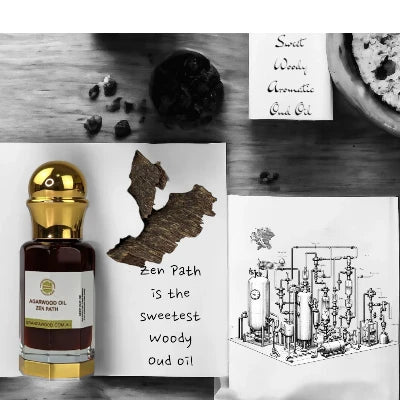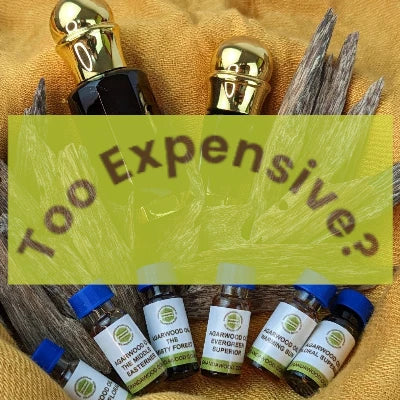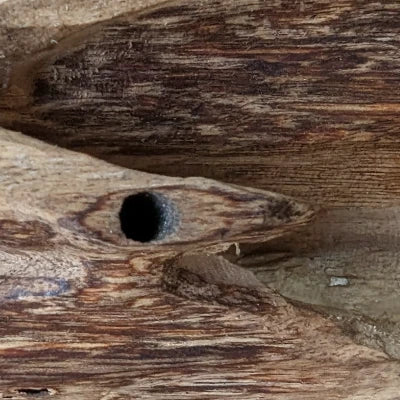Menu
-
-
F.A.Q
- How to identify genuine agarwood chip, natural or cultivated
- How to identify oil injection / absorption fake agarwood beads
- How to know if there are more than one oil in your oil
- How to make your wood bracelet or mala darker
- How to tell if an Agarwood bead sinks WITHOUT sinking it under water?
- How does back flow incense work and how do you burn it?
- Where to start if you don't know what agarwood is ?
- Why are you losing money if you buy seeds and plants?
- Which agarwood incense should I choose?
- Frequently Asked Questions
- Agarwood Related Articles
- Shipping
-
SHOP - Agarwood
-
SHOP - Other Fragrant Wood
-
SHOP - Incense Holder and Burner
-
- FREE guide book
- Testimonials
- "Why did you buy this?"
- Contact us
- About Us
- +61430284329
- Login
-
English


Adding "agarwood" oil into water, what happens next may surprise you - how to tell if your oud oil is a mixture
December 04, 2019 8 min read
Table of Contents:[hide]
Thinking of filing a Paypal Claim?
On Black Friday, you went online marketplace and found some oud (agarwood oil) with a "good" price because it was on special. You pulled out the credit card and checked out.
Two weeks later, you received the parcel in the mailbox. With excitement, you ripped the box open, having your oil presented in front of you.
Gently opened your cap, took a small dab on your wrist, smelled it and...
You felt something was not right. After trying several times, you became more suspicious. All you want would be the answer if this oud were 100% pure.
Frustrated, you contacted the seller, questioned him/her about the product. Being Friday afternoon, it meant the seller might not answer you until Monday.
Two days passed, you finally received an answer from the seller: "Hi, it was pure oud oil". That is? Without further explanation.
You wrote back and asked if the seller has any proof because something was not right. Let's supposed the seller has a lab test report, you need to learn what to look for.
However, how would you know if the report was for this particular oil that you purchased? It was out of your control.
With a large purchase, a big company would perform their testing. It made sense to spend a few hundred to verify the oil content as the investment could be five or 6-figure worth. But what if you only pay around one hundred for a bottle of oud oil, the test would cost more than the oil itself. Besides, the lab needs a minimum of 3ml; some even asked for 5ml to start with. So, it might not be a good option for some of you.
How are you going to get an answer without spending hundred of dollars in GCMS, or lab test?
Don't worry; you can perform a small test at home by just using water
Before we continue, I would like to let you know what is this test NOT FOR
- It is NOT a test to determine if the oil is 100% pure
- It is NOT a test to identify what oils or any other substances in a perfume or attar
What is for?
- It could tell you if there would be more than one oil are in perfume potentially. And from there, you could guess if the oil is 100% pure.
I will explain why
A lesson from a chemistry class
When I was in grade 6 middle school, and in chemistry class, my teacher demonstrated an experience about density
He explained some physical properties of water and he asked all of us followed him to a bigger classroom.
In that room, he brought out a rectangular tank, just like a fish tank. In that tank, it was half-filled with water.
He got a different glass container. Inside that container was a red liquid
- an object will sink or float by comparing its density to the density of water.
About the test
So I just introduced the principle how it works
In the below example, I will do this test for six different samples and show you the results.
How to identify if there is additional substance than essential oil in a solution
What you need:
- a glass tube or a small bottle
- water
Step 1: fill 3/4 of the tube with water.

Step 2: drop a small droplet of the "oil" into the water and close the cap.


Step 3: Shake violently.
Make sure the cap is tight before you start shaking.
How long? 5 to 10 seconds will do.
The magic happens here. When you shake, the oil breaks down into smaller droplets. Let it rest for 10 minutes. Once settled, you start observing. Below are the possible outcomes.

1) The mixture is cloudy, small droplets rise and stay ABOVE the water level. Once settled, the water is transparent while the oil clings to the sides of the tub

Why? Generally,
Essential oil floats because it is lighter than water (one of the exceptions was clove essential oil, which sinks because it is denser than water)
See the below oud oil in water distillation. The oil floats

After 15 minutes, all the droplets would gather on the top. The solution returned clear.
Look closely to see if there were any separate layers. If not, it was likely that there was only one essential oil in the sample.
Disclosure: This is our oud "Smooth Oud."

2) The mixture is cloudy; some small droplets sink, some stays in the middle while some floats.
There are four interesting parts of this example.
- 1: On top of the tube, you would see some milky substance
- 2: droplets that float
- 3: droplets that stay in the middle
- 4: droplets that sink

Each case is different, but from the above image, although I am unable to identify what exactly was inside this bottle, the sample is NOT pure essential oil. Here are the reasons
- It was claimed as pure oud oil. It does contain somewhat oud smell, but there are other scents too.
- The cloudy substance looks odd; it is certainly not a feature of oud.
- After 5 hours, the droplets which initially sank then floated and formed an "inverted mountain" shape. The cloudy substance remained unchanged. The solution turns clear.


Conclusion: This sample is NOT pure oud although there is some oud in the mixture.
3) The mixture is transparent; the bubble was formed on the top but dissipated later.
The product description was "natural oud perfume". The solution was clear; this is consistent with the product label "contains fractionated coconut oil" which is water-soluble.


4) the mixture was transparent, the droplets rose and formed a layer on the top. There was a bit of cloudy substance clinging on the side of the bottle
This sample smells like oud; there were two different oils here. One maybe oud, the second one was the cloudy stuff that was circled in red which may be a "trade secret sauce" (joking, I don't know what it was).
This sample contains more than one oil, so this vendor is not right when claiming this product is 100% pure oud oil.

5) The mixture is cloudy; the droplets rise at the top
This case is an easy one; essential oil does not mix with water. This oil was claimed as "oud perfume oil" which is true. It does smell oud, rose and citrus.

The solution was cloudy because of the presence of the non-toxic, water-soluble Dipropylene Glycol (DPG). The oil-based perfumes contain this as a solvent.
6) The mixture is transparent, the droplets 3/4 sink, 1/4 float
This sample is Oud oil from CO2 supercritical extract. Before doing this experiment, I guessed this CO2 oud oil would sink because 1 ml of this oud is 1.03g, which is denser than water. Isn't it interesting when "extracting" the same material - "pulverised agarwood"- one oil floats and the other one sinks?
Take ginger, for example, ginger essential oil and ginger CO2 extract oil are both floats above the water.

Ginger Co2 extract
Why CO2 oud oil sinks?
Being denser the water, it would sink. To dive deeper, I asked Dr WS, known as Kyarazen (I am a fan of his work). He messaged me which I was so grateful "Oleoresins have different lengths. Generally older materials, then oleoresin would tend to sink. In steam or hydrodistillation, you get most of the volatiles or short-chain stuff. CO2 can pull out the longer stuff, especially at supercritical."



To show you a comparison, I put it next to the cloudy number 5 (the oud oil perfume contains so water-soluble DPG)

The end of the experiment

1) Oud oil: this our oud to begin with :)
2) Claimed as pure oud oil: but it was not, there was more than one essential oil
3) Perfume Oud Oil with fractionated coconut oil:
4) Claimed as Pure Oud oil: this one got cloudy stuff on the surface, there was at least two different oil, so no, this is not pure oud. If you have this experience, contact seller
5) Perfume with DPG: DPG is water-soluble hence the cloudy solution
6) Agarwood oil, CO2 extract: as above, this contains longer-chain which is denser than water, it sinks. You can see some are above the water, according to Kyarazen, these are from shorter chain
Bonus
So I decided to get one old attar which I no longer used and pour some into the water. This experiment reminds me of the good old-time in class " the water vs oil experiment in high school."
I was not going to deep here as I did not know what contained in this attar exactly. I could detect pepper, citrus and "something familiar."
It had four layers after 2 hours.

So, next time, when in doubt, try this test.
Please note, this is not the test for 100% pure oud oil. This method is simply a test if there is any additional substance in a solution apart from essential oil.
Extra Bonus 2
When using an essential oil, if the label claimed it was pure, and you felt it was not from experience, do this little test to find out.
If the bottle contains an essential oil only, you will see a consistent layer. If the oil is denser than water, all the oil should be at the bottle of the test bottle or vial when you add water.
If you see something floats while others sink, it means that the solution is inconsistent. It contains more than one essential oil or more than one substance.
(Source: self-taken, the essential oil is floating up, the pink bottom pearls are synthetic vanilla)
Leave a comment
Comments will be approved before showing up.
Also in News

Anoint with The Zen Path, and you will never yearn for the artificiality that numbs the senses
March 03, 2024 2 min read

You say: “Your Agarwood is too expensive”. Let’s Reason Together - about Price
February 14, 2024 8 min read



